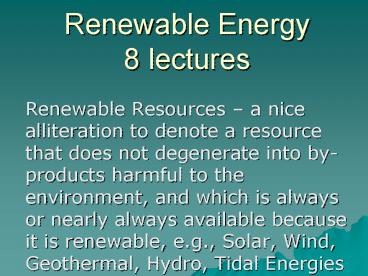Renewable Energy 8 lectures - PowerPoint PPT Presentation
1 / 29
Title:
Renewable Energy 8 lectures
Description:
Switch to renewable sources of energy (solar, biomass, wind, hydro, geothermal) Impediment ... Wind Energy. Solar Radiation, Air mass, Measurements ... – PowerPoint PPT presentation
Number of Views:1340
Avg rating:3.0/5.0
Title: Renewable Energy 8 lectures
1
Renewable Energy8 lectures
- Renewable Resources a nice alliteration to
denote a resource that does not degenerate into
by-products harmful to the environment, and which
is always or nearly always available because it
is renewable, e.g., Solar, Wind, Geothermal,
Hydro, Tidal Energies
2
Why?
The overriding theme of the Summit was to promote
action and major progress was made in
Johannesburg to address some of the most pressing
concerns of poverty and the environment.
Commitments were made to increase access to clean
water and proper sanitation, to increase access
to energy services, to improve health conditions
and agriculture, particularly in drylands, and to
better protect the world's biodiversity and
ecosystems.
3
In energy, Desai said countries committed
themselves to expanding access to the two billion
people that do not have access to modern energy
services. In addition, he added that while
countries did not agree on a target for phasing
in renewable energy, they did commit to green
energy and the phase out of subsidies for types
of energy that are not consistent with
sustainable development. And to bolster these
commitments, a group of nine major electric
companies signed agreements to undertake
sustainable energy project in developing
countries. In addition, the EU announced a 700
million partnership initiative on energy and the
US announced investments of up to 43 million for
energy in 2003.
4
Causes of Asian Brown Cloud Must Be Addressed by
Johannesburg Summit New York, 16 August The
three-kilometre thick layer of haze that hangs
over a wide expanse of territory covering South
Asia to South East Asia is a direct result of the
damaging development trends that the World Summit
on Sustainable Development must help reverse,
according to Summit Secretary-General Nitin
Desai.Known as the "Asian Brown Cloud," the
haze is comprised of particulate matter from
various aerosols, most caused by burning fossil
fuels and is causing lower temperatures and
changing precipitation patterns, including floods
and droughts. "This cloud of pollution is a
direct consequence of the unsustainable use of
energy in the region," Desai said. "It causes
respiratory disease and it wreaks havoc on
agriculture. And it is also something we can do
something about, if we are committed."
5
Global Warming
N.B. Changes like these have occurred in past
centuries!
6
One of three main causes of temperature changes
- Human activity INCREASES the amount of so called
GREEN HOUSE GASES in the atmosphere
7
What are Green House Gases?Naturally Ocurring
- Water vapor H2O
- Carbon Dioxide CO2
- Nitrous Oxide N2O
- Methane CH4
- Oxygen O2 and Ozone O3
8
What are Green House Gases?Man-made
(Anthropogenic)
- CO2
- N2O
- CH4
- Chlorofluro-carbons CFCs
9
A Green-house
Traps the suns energy (Physics of energy
absorption). Employed in cold climates to keep
plants warm
10
A Jamaican analogy for trapping of heat energy -
Does not work the same was as green-house gases
11
Atmospheric Green-house effect 1
12
The Problem
- The increased green-house gases due to human
activity appears to be making the earth warmer
(too much green-house effect) - going beyond the
range of natural variations in climate. - However we are not absolutely sure - we use
computer models which do not exactly replicate
atmospheric processes and we make assumptions of
which we are not certain.
13
For more information
14
Possible solution
- Switch from coal to oil or natural gas
- Switch to non-fossil fuel sources of energy
- Switch to renewable sources of energy (solar,
biomass, wind, hydro, geothermal)
- Impediment
- Renewable Energy is not cheap
15
Course Outline
- Solar Radiation, Air mass, Measurements
- Thermal Characteristics of Solar collectors
- Photovoltaic cells
- Wind Energy
16
Solar Radiation, Air mass, Measurements
Pyranometer with shadow band (Diffuse radiation)
Pyrheliometer (Direct radiation)
17
Solar Radiation
- Extraterrestrial The solar radiation incident
on the top of the atmosphere. Its measurement is
called the solar constant - Solar constant the rate at which the total
solar energy at all wavelengths is incident on a
unit area exposed normally to the sun at the mean
sun-earth distance - 1367 W/m2
- Also called air mass zero (AM0)
18
How much radiation is transmitted to earth
- Depends on mass of atmosphere or air mass
- Actual optical air mass
19
Passive solar water heaters
20
Cut-away of the flat plate collector
21
Thermo-syphoning
22
Short wave solar radiation
Long wave radiation
Transparent cover
Absorber plate
c
r
Fluid tube
Thermal insulation
b
r radiative loss c convective loss b back
loss
23
Photovoltaics
24
(No Transcript)
25
(No Transcript)
26
(No Transcript)
27
Hole
Direction of travel of hole
28
(No Transcript)
29
P type with holes in valance band and minority
carriers in conduction band
n type with electron in conduction band and
minority carriers in valance band































